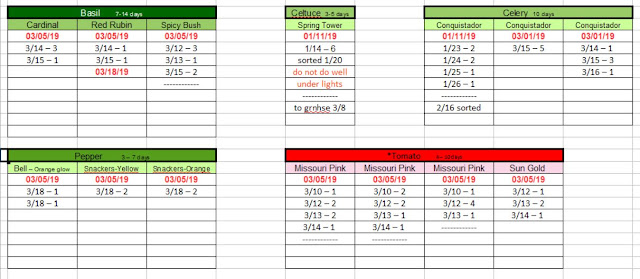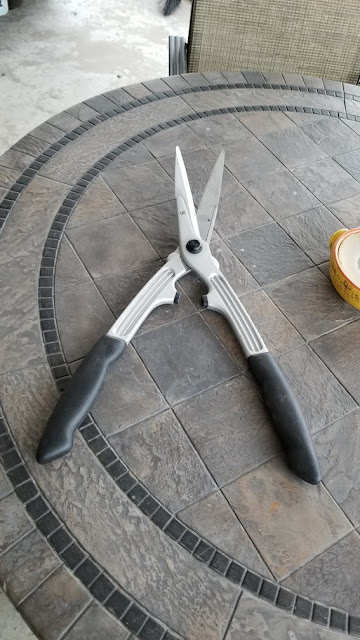We've come through a winter like the ones I remember as a child: frigid temps and lots of snow. I haven't seen one of those since I came back to Missouri in 2013 and started gardening. But I haven't
ever seen a long, hot summer like we had in 2018, and I hope I never do again. But who knows?
In January, we had a doozey of a snow - about 14" that piled on the bird feeders, tilting them to 45 degree angles, and covered everything in sight.
Following that, we had a heavy ice storm that took out a couple of very large tree limbs, shattering the small terminal branches into bits within a couple feet of the living room window and providing lots of pecking and hiding fun for all kinds of birds until the weather let up so a tree crew could come cut it up and shred it into a big mulch pile. (Does that qualify as a run-on sentence?) I assume the birds were finding insects, but I don't know.
Every blade of grass got its own coat.
The bird feeders' lids were frozen shut, so I had to just scatter seed on the ice-coated ground. A little birdie skating rink and cafe.
The mesh cover on the arbor turned into an inverted bed of nails.
Still, we have been more fortunate than
others around us in this record-setting late winter weather.
One good thing about the late winter: the rhubarb didn't try to come up early. So maybe I'll get by without having to cover it to protect against early spring freezes. Maybe.
Rhubarb emerging - mid March
I started so many new flowers this year that I had to add another strip light to my growing-on bed in the cellar. I also encased it in metal screening to prevent last year's disappointment: a mouse garden. They probably thought they hit the jackpot with green seedlings in the middle of winter. It's crowded and not as easy to work with, but I get to enjoy the rewards of my labor.
Seeded trays on heat mats
Seeded and labeled trays
top row: ornamental strawberry; globe amaranth; middle row: dianthus, yarrow
bottom row: zinnia, cabbage, dianthus, cardoon, tithonia (Mexican sunflower)
Don't ask me why I have such a compulsion to keep records, but I do. Perhaps it's from my days of research at UC Davis. It does come in handy when I wonder when to expect my seedlings to germinate, or if I should give up on them. But mostly it's for curiosity's sake. And it gives me an idea of what to be watching for in the spring that might have come up and needs attention. (As if I don't watch EVERYthing like a hawk as soon as the weather stops dipping into freezing territory.)
I have a complex set of records in an Open Office spreadsheet file that includes all my plot layouts, my seed starts, and a record of rain, seedling emergence, flowering and even bird sightings.
The weather finally turned toward spring-like so I could set up my portable greenhouse, but the very next day we had winds of 25 - 35 mph all day long. I thought for certain they would rip the aluminum and plastic thing out of the ground, but after last year's experience, I managed to batten it down securely enough that it held.
I'm afraid my ornamental vegetable garden is taking a back seat to my expanding rose and flower gardens. So expect to see as much or more of pretty flowers as you do vegetables. There's a list in the sidebar index (labels) on the right hand side of the page, so you can find specific plants you might be interested in rather than have to wade through a bunch of things you're not.
It all started with the roses. I planned to buy one hybrid tea rose per year, keep it in a pot on the patio until fall, then plant it in the garden. I planned for a total of five over five years. Hahahahahahaha. It's been three, and after moving two shrubs out of that plot that turned out to be more rambling than upright and replacing them with FOUR new varieties, there are twice that many in the rose garden. There's no space for more. (This year I also added a climber on the garden arbor and two ramblers, thanks to a generous birthday gift from my sister, on the yard bank near the highway.)
It's only fitting. The name of this farm is "Rose Hill". I assume at one time a hundred years or so back, there were roses. I'm going to try to air layer most of them so I'll always have at least two of each in case I lose one. I've not had any luck trying to root them, so I'm hoping I'll have better luck this way. And then what will I do with them if I do have good luck? Prepare another plot, but boy, do I dread that chore again.
I order my roses from
Palatine Roses in Canada, and they send beautifully healthy bare root plants in March. This year, from them and other nurseries, I ended up with seven roses, a lily, Siberian iris, and echinacea that I couldn't plant, because the GROUND WAS STILL FROZEN and the top 2 - 6" was positively saturated from snow melt and rain until just a few days ago.
The ground was so wet that I put on my wellies and walked the vegetable garden paths that will eventually get mulched, sinking in enough to make troughs. I won't have to do any digging out of the soil this year to keep the mulch in its place!
The bulbs, roots and tubers I ordered can keep until the ground is suitable for planting. (I did manage to get the Siberian iris in the ground today.) But I had to
heel in the roses, and to do that, I had to have soil, not bog. The day before they were to arrive, knowing it was going to rain again the next day, I took large plastic sheets and tarped my giant compost hill, so that when the roses arrived, I could find a dry enough spot to bury them.
Two days following that, I was able to dig holes in the rose garden, amending them with dry - well, drier - composted manure, and given three sunny days, I was able to finally able to plant them.
I also planted two muscat grapes at the garden arbor, and potted up a 'Pink Lemonade' blueberry, all of which I got from
Stark Brothers. I had potted up the grape vines until I could get them into the ground, but I had too many roses to do that with them.
I'm slowly taking over more and more of the wildflower garden next to my rose garden to plant perennials and cut flowers. Don't worry. The wildflower garden is huge. I say slowly, because it is a bear of a job to dig out 20-year-old echinacea, monarda, rudbeckia, and the like. Not to mention the fescue and other grasses that are taking over.
Perennial bed in progress
I finally got smart last year. When I raked up leaves for this year's mulch, I chopped them up with the lawnmower before bagging them. Works very well.
Thanks to a generous Christmas gift from my son, I got some nice manual hedge clippers that work very nicely, and I used them to chop back the lavender, tarragon, oregano, perovskia and mound fescue. Soooo much easier than using hand clippers!
Check out my
tools page (always linked at the top of the site) for other equipment I can't live without.
This is actually one of my favorite times of the year, seeing the new growth after a long winter, and knowing that my favorite perennials I grew from seed survived.
Lupine
Belladonna Delphinium
So, we're off! Another year. I wonder how this one will go.
Don't forget to let me know about your gardening adventures. Comments to the posts are always welcome. Unlike most blogs, this particular design for some reason has the comment link at the top of each post instead of the bottom, and coding has become so much more complicated than when I used to do it that I can't find where to change it.
Be well, and enjoy the signs of spring.



































